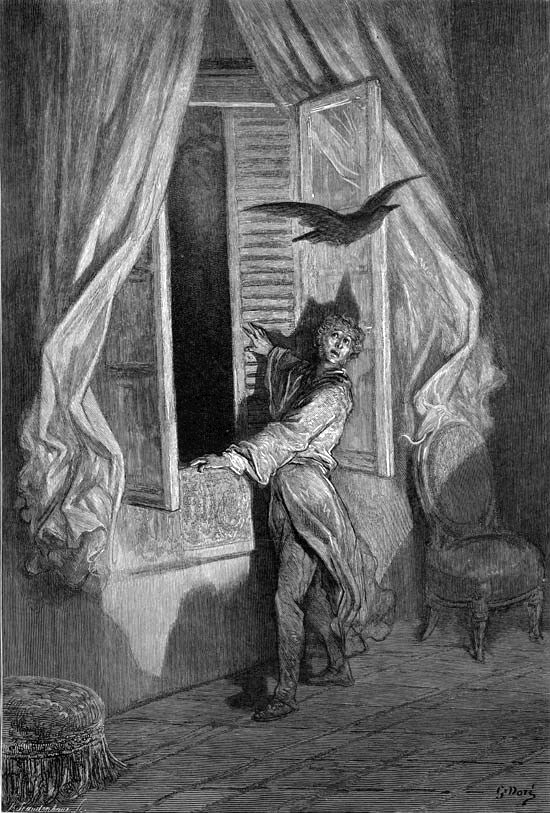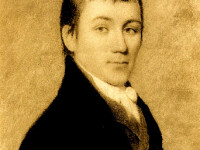
GUstave Doré, Illustration 14 for “The Raven” by Edgar Allan Poe for the line “Not the least obeisance made he.”
On January 29, 1845, Edgar Allan Poe‘s famous narrative poem ‘The Raven‘ was first published in the New York Evening Mirror. It has become one of the best known English poems of all time. The Raven makes use of a number of folk and classical references and is often noted for its musicality, stylized language, and supernatural atmosphere.
All the Chasms Lurking in the Human Soul…
We already had an article of Edgar Allan Poe’s mysterious death.[5] On October 3, 1849, Poe was found on the streets of Baltimore delirious laying in the gutter. He was taken to the Washington Medical College, where he died on Sunday, October 7, 1849, at 5:00 in the morning. Poe was never coherent long enough to explain how he came to be in his dire condition, and, oddly, was wearing clothes that were not his own. Poe was the very first US-American writer, who was able to make a living from his profession. His legacy of dark romantic novels, stories, and poems has become part of our common cultural heritage and are still popular today. I learned about Poe’s ‘Tales of Mystery and Imagination‘ already back in school, where I was really fascinated about all the chasms lurking in the human soul that he opened up in his writings.
The Raven
Edgar Allan Poe’s most prominent poem for sure is ‘The Raven‘.
Once upon a midnight dreary, while I pondered, weak and weary,
Over many a quaint and curious volume of forgotten lore –
While I nodded, nearly napping, suddenly there came a tapping,
As of some one gently rapping, rapping at my chamber door.
“‘Tis some visiter,” I muttered, “tapping at my chamber door – Only this and nothing more…”
The Poem’s Inspirations
Poe claimed to have written his famous poem very logically and methodically, intending to create a poem that would appeal to both critical and popular tastes [1]. The poem was inspired in part by a talking raven in the Charles Dickens novel ‘Barnaby Rudge: A Tale of the Riots of ‘Eighty‘ [2,6]. Poe borrows the complex rhythm and meter of Elizabeth Barrett-Browning‘s poem “Lady Geraldine’s Courtship“, and makes use of internal rhyme as well as alliteration throughout.[7] The publication of “The Raven” made Poe widely popular in his lifetime, although it did not bring him much financial success. Soon reprinted, parodied, and illustrated, critical opinion is divided as to the poem’s status, but it nevertheless remains one of the most famous poems ever written.
Ah, distinctly I remember it was in the bleak December;
And each separate dying ember wrought its ghost upon the floor.
Eagerly I wished the morrow; – vainly I had sought to borrow
From my books surcease of sorrow – sorrow for the lost Lenore –
For the rare and radiant maiden whom the angels name Lenore –
Nameless here for evermore.
The Poem’s Main Theme
The main theme of the poem is one of undying devotion. In the poem, the narrator experiences a perverse conflict between desire to forget and desire to remember. He seems to get some pleasure from focusing on his loss. The narrator assumes that the infamous word “Nevermore” is the raven’s “only stock and store“. Nevertheless he continues to ask it questions, knowing that the answer always will be the very same. His questions, then, are purposely self-deprecating and further incite his feelings of loss.
And the silken, sad, uncertain rustling of each purple curtain
Thrilled me – filled me with fantastic terrors never felt before;
So that now, to still the beating of my heart, I stood repeating
“‘Tis some visiter entreating entrance at my chamber door –
Some late visiter entreating entrance at my chamber door; – This it is and nothing more.”
US$ 15 for Charity…
Poe first brought “The Raven” to his friend and former employer George Rex Graham of Graham’s Magazine in Philadelphia, who declined the poem, though he gave Poe $15 as charity. Poe then sold the poem to The American Review, which paid him $9 for it, and printed “The Raven” in its February 1845 issue under pseudonym, although the poem’s first publication with Poe’s name was in the Evening Mirror on January 29, 1845. The immediate success of “The Raven” prompted the Wiley and Putnam to publish a collection of Poe’s prose called Tales in June 1845. It was Poe’s first book in five years – and the first poems in fourteen years.
Presently my soul grew stronger; hesitating then no longer,
“Sir,” said I, “or Madam, truly your forgiveness I implore;
But the fact is I was napping, and so gently you came rapping,
And so faintly you came tapping, tapping at my chamber door,
That I scarce was sure I heard you” – here I opened wide the door; –Darkness there and nothing more.
Deep into that darkness peering, long I stood there wondering, fearing,
Doubting, dreaming dreams no mortal ever dared to dream before;
But the silence was unbroken, and the stillness gave no token,
And the only word there spoken was the whispered word, “Lenore?”
This I whispered, and an echo murmured back the word, “Lenore!” – Merely this and nothing more. [click to continue]
Readers began to identify poem with poet, earning Poe the nickname “The Raven“. The poem was praised by fellow writers William Gilmore Simms and Margaret Fuller, though it was denounced by William Butler Yeats, who called it “insincere and vulgar” as well as by Ralph Waldo Emerson.[8,9] “The Raven” has influenced many modern works, including Vladimir Nabokov‘s Lolita and Ray Bradbury‘s “The Parrot Who Knew Papa” in 1976, as well as Charles Baudelaire and even composer Maurice Ravel. Until today throughout popular culture the poem is referenced in films, television, music, and video games.
Barry Wood, Edgar Allen Poe: Tales of Mystery and Terror, [11]
References and further Reading:
- [1] Edgar Allan Poe: The Philosophy of Composition, from Graham’s Magazine, vol. XXVIII, no. 4, April 1846, 28:163-167.
- [2] Charles Dickens: Barnaby Rudge, full text at gutenberg.org
- [3] Elizabeth Barrett Browning: Lady Geraldine’s Courtship – A Romance of the Age
- [4] The works of Edgar Allan Poe in wikisource
- [5] The Mysterious Death of Edgar Allan Poe, SciHi Blog
- [6] Charles Dickens – Famous Writer and Critic of the Victorian Era, SciHi Blog
- [7] Victorian Art, Love, and Poetry – Elizabeth Barrett Browning, SciHi Blog
- [8] Ralph Waldo Emerson and the Transcendentalism Movement, SciHi blog
- [9] William Butler Yeats and Modern English Literature, SciHi Blog
- [10] Timeline for Edgar Allan Poe, via Wikidata
- [11] Barry Wood, Edgar Allen Poe: Tales of Mystery and Terror, ENGL 3350 American Literature to 1850, UHouston @ youtube
- [12] Works by or about Edgar Allan Poe at Internet Archive





